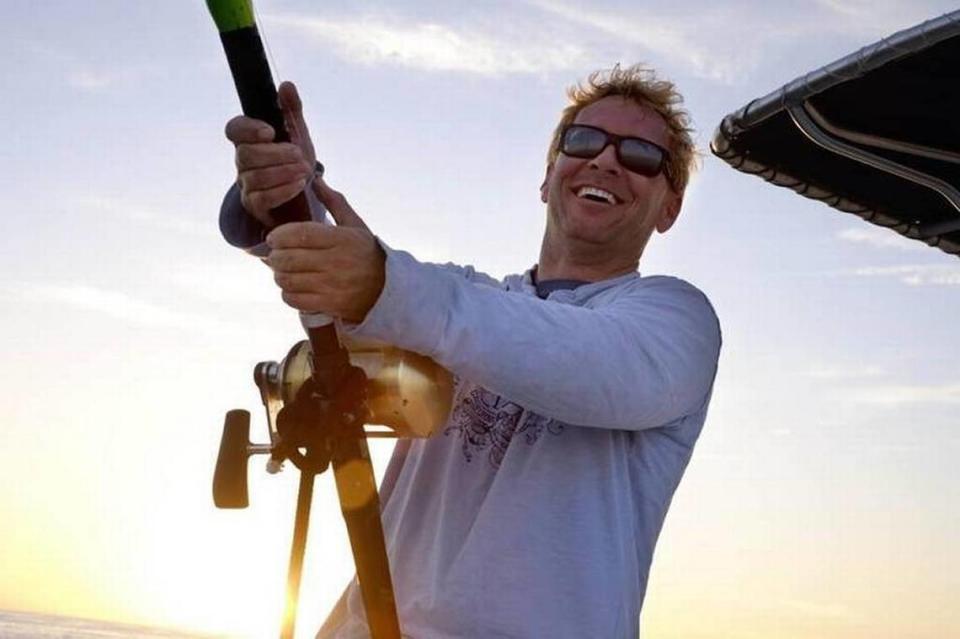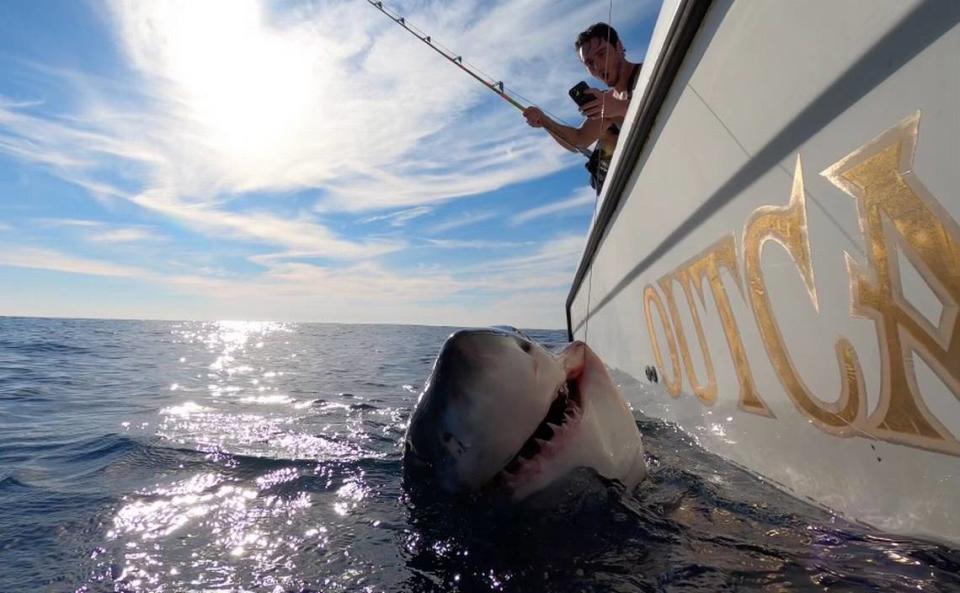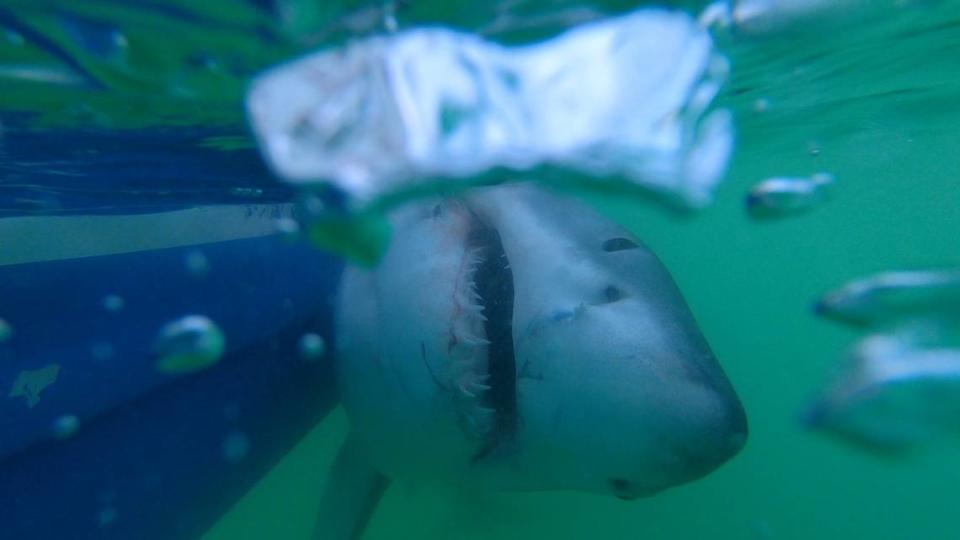Hilton Head’s shark whisperer: A decade tagging great whites reveal their winter mysteries
Biologists say Chip Michalove is magic.
The ones he works with can’t recall anyone else in the Southeast who can consistently reel in as many great white sharks as the Hilton Head Island charter captain.
But Michalove, with no biology degree and boat-load of charisma, would tell you himself that sleepless nights and obsessive planning are behind his prolific ability to capture, tag and release dozens of the apex predators in the past decade.
The Kentucky native was hooked from the time he caught his first shark on a fishing trip in Hilton Head’s waters when he was a little boy. Now, more than four decades later, Michalove’s mark is one he could’ve never imagined.

He’s been called the white shark whisperer. He’s appeared on National Geographic and The Discovery Channel’s Shark Week. His name has popped up on several major media outlets over the years. To the general public, they see his bounding energy and shock of blonde hair, as he reels in massive fish with a rocky reputation.
But look closer and listen harder, because Michalove’s imprint goes further than pure adrenaline. He struck gold and a symbiotic relationship with the scientific community — catching, tagging and releasing the sharks in partnership with the Atlantic White Shark Conservancy.
“What shark is swimming away with about $10,000 worth of the satellite equipment?” Michalove said. “I never thought I’d be applying this type of technology to a shark.”
With his typical effervescence, he adds that the journey beyond his belief has been “Amazing!”
And it’s far from over.
Partnering with science
Nearly 10 years ago, on Jan. 29, 2014, Michalove hooked his first great white. He thought to himself “this is once in a lifetime.”
Then, the unparalleled experience wriggled off his hook.
When the charter captain called an Island Packet and Beaufort Gazette reporter to tell him about the first-ever great white caught off Hilton Head’s waters, the reporter pushed back. The claim was “too far-fetched,” Michalove recalled the reporter saying to him. There was no data showing a white shark had been caught in South Carolina waters.
Days later, there was proof in the pudding. The rest was history, and an unpredictable one at that, with over 120 hooked white sharks by this fall.
“It just kind of snowballed,” Michalove said. “If you would have told me 10 years ago that I was gonna be on Shark Week with Snoop Dogg, I would have said ‘You’re crazy.’ Now I’ve got the top scientists in the world fishing with me.”
Before a nonprofit organization stationed in North Chatham, Massachusetts, snagged the vivacious charter captain, he was working with South Carolina’s Department of Natural Resources by tagging tiger sharks in the Port Royal Sound.
When attached to a shark, acoustic and PSAT tags show the species’ movement and migration patterns. The tags let scientists know the saltiness of the water they prefer, the depths they swim down, and alert receivers when the shark is in certain waters.
New England Shark Biologist John Chisholm told Greg Skomal, with the Atlantic White Shark Conservancy, about a South Carolina charter captain who was good at targeting white sharks.
By 2016, Michalove tagged his first shark for the Atlantic White Shark Conservancy, a regional organization leading white shark research. Since then, according to Michalove, the Hilton Head legend has tagged 36 great whites for the organization.
“That’s very, very impressive,” Skomal said.
Michalove’s tagged white shark was the“first time shark scientists ever had access to these animals in the Northwest Atlantic,” said Megan Winton, a scientist who works alongside Skomal.
In Cape Cod, where there’s a concentrated white shark population that feeds on seals in shallow water, it’s easier to tag the apex predators. They have upwards of 260 tagged up north. But when the sharks swim south in the winter, it’s a different story. They spread out far and wide.
“Chip’s kind of like magic,” Winton said.
And maybe Michalove’s magic was sparked over four decades ago.
Building a legacy
Fuzzy Davis, an island charter captain with 40 years of experience under his belt, remembers Michalove as a boy on the day they caught the black tip shark. It was Michalove’s first catch.
The shark was 6 feet long and, understandably, little Michalove was terrified.
“I was scared to death and crying,” Michalove told the Island Packet and Beaufort Gazette in 2017. “But afterward I thought it was the coolest thing in the world. I went back to Kentucky and put signs up all over the lake with my phone number saying ‘guide for hire.’”
Reunited on Hilton Head decades later, Michalove and Davis laud each other for their accomplishments. Michalove calls his senior the “godfather of fishing.” Davis dubbed his junior a “modern-day pioneer.”
Thinking back to the little boy petrified by a 6-foot black tip stirs up laughter in Davis.
“It’s so funny to think of now that he’s almost putting his hand down the throats of these sharks,” he said of the now 47-year-old. “It’s like nothing nobody else would do.”
In 1989, the ocean-lover returned to the island. By 23, wanting to nix dreaded college talk and determined to become a successful charter fisherman, he purchased a boat and kicked-off his charter business.
There was no overnight success.
Michalove waited tables. Drove a limousine. Power-washed. His fishing season was June through August, different from his now 12-month season. Suffice it to say, he was living week to week.
Knowing that he looked far younger than he was, Michalove knew his customers’ trust wasn’t inevitable. So, he guaranteed an 8-foot shark for every trip or their money back. For three years, he didn’t have to return a single dime, but it was a feat that bred so much stress that he ended up with a stomach ulcer.

To make money on the side, he entered kill tournaments — fishing sharks for sport and garnering rewards, both money and state records.
When he hauled in a record-sized lemon shark at 35 years old, he asked a scientist in Charleston the dead fish’s age. She estimated it was about 35. At that moment, Michalove knew he was done with kill tournaments. They’d been on the earth for the same amount of years, he mulled over and over.
“There’s no reason to drag in 30, 40-year-old tiger sharks so you can win a few $1,000 dollars,” Michalove said, who admitted he’s not proud of that past. “But I was doing that, and I didn’t realize how important they are to our local ecosystem. I didn’t realize that I was chopping down my cherry tree.”
Sure, harvesting fish sustainably is OK, he said. But species with slow reproductive systems and ones that other creatures of the sea rely on — like large sharks — should be left alone.
Michalove began speaking out about the tournaments, admonishing them. And he credits scientists for molding his genuine fascination into a researcher’s dream.
Pressure of white shark catch
Out on his 26-foot boat named Outcast, not far from his charter business with the Outcast Sport Fishing moniker, Michalove is a bundle of energy.
The days are long, Winton said, and only sometimes does she see Michalove get quiet.
“You can tell his mind is going, he’s thinking about things,” she said. “There are a lot of choices he has to make in the course of the given day out there. And you know, I can only imagine it. It’s a lot of pressure.”
The similar pressures came when he had three days with the Shark Week team to produce a great white catch. Of course, it was after one of South Carolina’s harshest winters. On day one, they lost the shark. But two weeks later, the crew came back and a dead whale washed up. It was a feeding frenzy.
That could’ve been the magic Winton was talking about. Or just luck. But really, in order to tag the number of white sharks Michalove has for the Conservancy, it’s taken endless patience and studying.
“When you prep for a great white shark, everything has to be perfect,” Michalove said. “If there’s one little thing wrong with your whole leader system, your whole setup, it’s gonna break.”
Every knot, every crimp, the sharpness of the hook and weather conditions all have to be perfect. He’ll study the currents and water temperature on days he sees great success. And even on Sunday, his only day off, he stresses over and prepares for the setup. But duplication is rarely guaranteed.
Winton says Michalove will constantly tell her that he’s not a scientist. But she won’t hear it.
“He’s been studying this fish more and probably more intensely even than a lot of scientists,” she said. “A lot of times people seem to think that scientists are at odds with fishermen and fishing communities, but it’s really not the case.”
Michalove’s work with the Conservancy has helped identify migratory patterns of dozens of white sharks swimming thousands of miles – some all the way up to Nova Scotia and back down to Pensacola, Florida, in a 12-month span.
When sharks are down off the southeastern United States, they’re not hunting big prey like seals, so their behavior changes, Skomal said. Every tag increases understanding of that behavior where the sharks overwinter.
What’s next in the shark world?
The relationship between the Conservancy and Michalove is what he calls “perfect storm” of information. One that’s made him a better fisherman.
Biologists in a lab know exactly how much a white shark’s liver weighs and its gestation period. While he can assess the exact water temperatures and clarity his tagged sharks prefer.
For a man whose icon is Frank Mundus, the first to catch a white shark in the Atlantic and the inspiration for Quint’s character in “Jaws,” Davis said Michalove has reached beyond that status. While he hasn’t reeled in the 3,000-plus pound sharks Mundus had (yet), Michalove’s contributions to science have put Hilton Head on the map.

But what’s next for the mile-a-minute Michalove? Shark-propelled video footage.
A newfangled camera tag, attached to a dorsal fin, allows about 10 hours of footage. The 20 that have been deployed by the Conservancy have unveiled peculiarities. They’ve witnessed a shark get zapped by a torpedo, stunned by seals and diving birds, staring curiously at rocks and buoys, and relying on the current after eating to push water through its gills instead of constant swimming.
The tags also contain a three-dimensional sensor that allows scientists to look at the sharks’ movements and behavior. It records data 20 times a second, which Winton said is essentially like they’re giving smartphones to white sharks and downloading an app to track their swim.
Winton’s the first to say she’s been pushing Michalove to begin tagging with the cutting-edge technology. And the charter captain, who has never let doubt get in his way, is the first to respond that he’s ready.
“It’s gonna be wild,” Michalove said.

